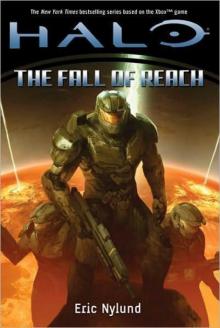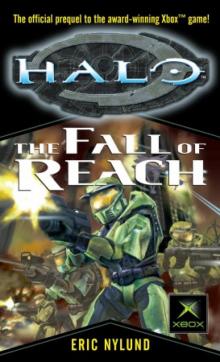- Home
- Eric Nylund
Halo: The Fall of Reach Page 2
Halo: The Fall of Reach Read online
Page 2
Soon there would be no more colonies, no human settlements—and nowhere left to run.
SECTION I REVEILLE
CHAPTER ONE
0430 Hours, August 17, 2517 (Military Calendar) / Slipstream space unknown coordinates near Eridanus Star System
Lieutenant Junior Grade Jacob Keyes awoke. Dull red light filled his blurry vision and he choked on the slime in his lungs and throat.
“Sit up, Lieutenant Keyes,” a disembodied male voice said. “Sit. Take a deep breath and cough, sir. You need to clear the bronchial surfactant.”
Lieutenant Keyes pushed himself up, peeling his back off the formfitting gel bed. Wisps of fog overflowed from the cryogenic tube as he clumsily climbed out. He sat on a nearby bench, tried to inhale, and doubled over, coughing until a long string of clear fluid flowed from his open mouth.
He sat up and drew his first full breath in two weeks. He tasted his lips and almost gagged. The cryo inhalant was specially designed to be regurgitated and swallowed, replacing nutrients lost in the deep sleep. No matter how they changed the formula, though, it always tasted like lime-flavored mucus.
“Status, Toran? Are we under attack?”
“Negative, sir,” the ship’s AI replied. “Status normal. We will enter normal space near the Eridanus System in forty-five minutes.”
Lieutenant Keyes coughed again. “Good. Thank you, Toran.”
“You’re welcome, Lieutenant.”
Eridanus was on the border of the Outer Colonies. It was just far enough off the beaten path for pirates to be lurking . . . waiting to capture a diplomatic shuttle like theHan . This ship wouldn’t last long in a space action. Theyshould have an escort. He didn’t understand why they had been sent alone—but Junior Lieutenants didn’t question orders. Especially when those orders came from FLEETCOM HQ on planet Reach.
Wake-up protocols dictated that he inspect the rest of the crew to make sure no one had run into problems reviving. He looked around the sleep chamber: rows of stainless steel lockers and showers, a medical pod for emergency resuscitations, and forty cryogenic tubes—all empty except the one to his left.
The other person on theHan was the civilian specialist, Dr. Halsey. Keyes had been ordered to protect her at all costs, pilot this ship, and generally stay the hell out of her way. They might as well have asked him to hold her hand. This wasn’t a military mission; it was baby-sitting. Someone at Fleet Command must have him on their blacklist.
The cover of Dr. Halsey’s tube hummed open. Mist rippled out as she sat up, coughing. Her pale skin made her look like a ghost in the fog. Matted locks of dark hair clung to her neck. She didn’t look much older than him, and she was lovely—not beautiful, but definitely a striking woman. For a civilian, anyway.
Her blue eyes fixed upon the Lieutenant and she looked him over. “We must be near Eridanus,” she said.
Lieutenant Keyes almost saluted reflectively, but checked the motion. “Yes, Doctor.” His face reddened and he looked away from her slender body.
He had drilled in cryogenic recovery a dozen times at the Academy. He’d seen his fellow officers naked before—men and women. But Dr. Halsey was a civilian. He didn’t know what protocols applied.
Lieutenant Keyes got up and went to her. “Can I help you—”
She swung her legs out of the tube and climbed out. “I’m fine, Lieutenant. Get cleaned up and dressed.” She brushed past him and strode to the showers. “Hurry. We have important work to do.”
Lieutenant Keyes stood straighter. “Aye, aye, Ma’am.”
With that brief encounter, their roles and the rules of conduct crystallized. Civilian or not—like it or not —Lieutenant Keyes understood that Dr. Halsey was in charge.
The bridge of theHan had an abundance of space for a vessel of its size. That is, it had all the maneuvering room of a walk-in closet. A freshly showered, shaved, and uniformed Lieutenant Keyes pulled himself into the room and sealed the pressure door behind him. Every surface of the bridge was covered with monitors and screens. The wall on his left was a single large semicurved view screen, dark for the moment because there was nothing in the visible spectrum to see in Slipspace.
Behind him was theHan ’s spinning center section, containing the mess, the rec room, and the sleep chambers. There was no gravity on the bridge, however. The diplomatic shuttle had been designed for the comfort of its passengers, not the crew.
It didn’t seem to bother Dr. Halsey. Strapped into the navigator’s couch, she wore a white jumpsuit that matched her pale skin, and had tied her dark hair into a simple, elegant knot. Her fingers danced across four keypads, tapping in commands.
“Welcome, Lieutenant,” she said without looking up. “Please have a seat at the communication station and monitor the channels when we enter normal space. If there’s so much as a squeak on nonstandard frequencies, I want to know instantly.”
He drifted to the communication station and strapped himself down. “Toran?” she asked. “Awaiting your orders, Dr. Halsey,” the ship AI replied. “Give me astrogation maps of the system.” “Online, Dr. Halsey.” “Are there any planets currently aligned with our entry trajectory and Eridanus Two? I want to pick up a
gravitational boost so we can move in-system ASAP.” “Calculating now, Doctor Hal—” “And can we have some music? Rachmaninov’s Piano Concerto Number Three, I think.” “Understood Doctor—” “And start a preburn warm-up cycle for the fusion engines.” “Yes, Doc—” “And stop spinning theHan ’s central carousel section. We may need the power.” “Working . . . ” She eased back. The music started and she sighed. “Thank you, Toran.”
“You’re welcome, Dr. Halsey. Entering normal space in five minutes, plus or minus three minutes.”
Lieutenant Keyes shot the doctor an admiring glance. He was impressed—few people could put a shipboard AI through its paces so rigorously as to cause a detectable pause. She turned to face him. “Yes, Lieutenant? You have a question?” He composed himself and pulled his uniform jacket taut. “I was curious about our mission, ma’am. I
assume we are to reconnoiter something in this system, but why send a shuttle, rather than a prowler or a
corvette? And why just the two of us?” She blinked and smiled. “A fairly accurate assumption and analysis, Lieutenant. Thisis a reconnaissance mission . . . of sorts. We are here to observe a child. The first of many, I hope.”
“A child?” “A six-year-old male, to be precise.” She waved her hand. “It may help if you think of this purely as a
UNSC-funded physiological study.” Every trace of a smile evaporated from her lips. “Which is precisely what you are to tell anyone who asks. Is that understood, Lieutenant?” “Yes, Doctor.” Keyes frowned, retrieved his grandfather’s pipe from his pocket, and turned it end over end. He couldn’t
smoke the thing—igniting a combustible on the flight deck was against every major regulation on a UNSC space vehicle—but sometimes he just fiddled with it or chewed on the tip, which helped him think. He stuck it back into his pocket, and decided to push the issue and find out more.
“With all due respect, Dr. Halsey, this sector of space is dangerous.”
With a sudden deceleration, they entered normal space. The main view screen flickered and a million stars snapped into focus. TheHan dove toward a cloud-swirled gas giant dead ahead. “Stand by for burn,” Dr. Halsey announced. “On my mark, Toran.” Lieutenant Keyes tightened his harness. “Three . . . two . . . one.Mark. ” The ship rumbled and sped faster toward the gas giant. The pull of the harness increased around the
Lieutenant’s chest, making breathing difficult. They accelerated for sixty-seven seconds . . . the storms
of the gas giant grew larger on the view screen—then theHan arced up and away from its surface.
Eridanus drifted into the center of the screen and filled the bridge with warm orange light.
“Gravity boost complete,” Toran chimed. “ETA to Eridanus is forty-two minutes, three seconds.”
>
“Well done,” Dr. Halsey said. She unlocked her harness and floated free, stretching. “I hate cryo sleep,” she said. “It leaves one so cramped.”
“As I was saying before, Doctor, this system is dangerous—”
She gracefully spun to face him, halting her momentum with a hand on the bulkhead. “Oh yes, I know how dangerous this system is. It has a colorful history: rebel insurrection in 2494, beaten down by the UNSC two years later at the cost of four destroyers.” She thought a moment, then added, “I don’t believe the Office of Naval Intelligence ever found their base in the asteroid field. And since there have been organized raids and scattered pirate activity nearby, one might conclude—as ONI clearly has—that the remnants of the original rebel faction are still active. Is that that what you were worried about?”
“Yes,” the Lieutenant replied. He swallowed, his mouth suddenly dry, but he refused to be cowed by the doctor—by acivilian . “I need hardly remind you that it’s my job to worry about our security.”
She knew more than he did, much more, about the Eridanus System—and she obviously had contacts in the intelligence community. Keyes had never seen an ONI spook—to the best of his knowledge anyway. Mainline Navy personnel had elevated such agents to near-mythological status.
Whatever else he thought of Dr. Halsey, he would assume from now on that she knew what she was doing.
Dr. Halsey stretched once more and then strapped herself back onto the navigation couch. “Speaking of pirates,” she said with her back now to him, “weren’t you supposed to be monitoring communication channels for illegal signals? Just in case someone takes undue interest in a lone, unescorted, diplomatic shuttle?”
Lieutenant Keyes cursed himself for his momentary lapse and snapped to. He scanned all frequencies and had Toran cross-check their authentication codes.
“All signals verified,” he reported. “No pirate transmissions detected.”
“Continue to monitor them, please.”
An awkward thirty minutes passed. Dr. Halsey was content to read reports on the navigational screens,
and kept her back to him. Lieutenant Keyes finally cleared his throat. “May I speak candidly, Doctor?” “You don’t need my permission,” she said. “By all means, speak candidly, Lieutenant. You’ve been
doing a fine job so far.” Under normal circumstances, among normal officers, that last remark would have been insubordination
—or worse, a rebuke. But he let it pass. Normal military protocols seemed to have been jettisoned on this flight. “You said we were here to observe a child.” He shook his head dubiously. “If this is a cover for real
military intelligence work, then, to tell the truth, there are better-qualified officers for this mission. I graduated from UNSC OCS only seven weeks ago. My orders had me rotated to theMagellan . Those orders were rescinded, ma’am.”
She turned and scrutinized him with icy blue eyes. “Go on, Lieutenant.” He reached for his pipe, but then checked the motion. She would probably think it a silly habit. “If this is an intel op,” he said, “then . . . then I don’t understand why I’m here at all.” She leaned forward. “Then, Lieutenant, I shall be equally candid.” Something deep inside Lieutenant Keyes told him he would regret hearing whatever Dr. Halsey had to
say. He ignored the feeling. He wanted to know the truth. “Go ahead, Doctor.” Her slight smile returned. “You are here because Vice Admiral Stanforth, head of Section Three of
UNSC Military Intelligence Division, refused to lend me this shuttle without at least one UNSC officer aboard—even though he knows damn well that I can pilot this bucket by myself. So I picked one UNSC officer. You.” She tapped her lower lip thoughtfully and added, “You see, I’ve read your file, Lieutenant. All of it.”
“I don’t know—”
“Youdo know what I’m talking about.” She rolled her eyes. “You don’t lie well. Don’t insult me by trying again.” Lieutenant Keyes swallowed. “Then why me?Especially if you’ve seen my record?”
“I chose you preciselybecause of your record—because of the incident in your second year at OCS. Fourteen ensigns killed. You were wounded and spent two months in rehabilitation. Plasma burns are particularly painful, I understand.”
He rubbed his hands together. “Yes.”
“The Lieutenant responsible was your CO on that training mission. You refused to testify against him despite overwhelming evidence and the testimony of his fellow officers . . . and friends.”
“Yes.”
“They told the board of review the secret the Lieutenant had entrusted to you all—that he was going to test his new theory to make Slipspace jumps more accurate. He was wrong, and you all paid for his eagerness and poor mathematics.”
Lieutenant Keyes studied his hands and had the feeling of falling inward. Dr. Halsey’s voice sounded distant. “Yes.”
“Despite continuing pressure, you never testified. They threatened to demote you, charge you with insubordination and refusing a direct order—even discharge you from the Navy.
“Your fellow officer candidates testified, though. The review board had all the evidence they needed to court-martial your CO. They put you on report and dropped all further disciplinary actions.”
He said nothing. His head hung low.
“That is why you are here, Lieutenant—because you have an ability that is exceedingly rare in the military. You can keep a secret.” She drew in a long breath and added, “You may have to keep many secrets after this mission is over.”
He glanced up. There was a strange look in her eyes. Pity? That caught him off guard and he looked away again. But he felt better than he had since OCS. Someone trusted him again.
“I think,” she said, “that you would rather be on theMagellan . Fighting and dying on the frontier.”
“No, I—” He caught the lie as he said it, stopped, then corrected himself. “Yes. The UNSC needs every man and woman patrolling the Outer Colonies. Between the raiders and insurrections, it’s a wonder it all hasn’t fallen apart.”
“Indeed, Lieutenant, ever since we left Earth’s gravity, well, we’ve been fighting one another for every cubic centimeter of vacuum—from Mars to the Jovian Moons to the Hydra System Massacres and on to the hundred brushfire wars in the Outer Colonies. It has always been on the brink of falling apart. That’s why we’re here.”
“To observe one child,” he said. “What difference could a child make?”
One of her eyebrows arched. “This child could be more useful to the UNSC than a fleet of destroyers, a thousand Junior Grade Lieutenants—or evenme . In the end, the child may be the only thing that makesany difference.”
“Approaching Eridanus Two,” Toran informed them.
“Plot an atmospheric vector for the Luxor spaceport,” Dr. Halsey ordered. “Lieutenant Keyes, make ready to land.”
CHAPTER TWO
1130 Hours, August 17, 2517 (Military Calendar) / Eridanus Star System, Eridanus 2, Elysium City
The orange sun cast a fiery glow on the playground of Elysium City Primary Education Facility No. 119. Dr. Halsey and Lieutenant Keyes stood in the semishade of a canvas awning and watched children as they screamed and chased one another and climbed on steel lattices and skimmed gravballs across the repulsor courts.
Lieutenant Keyes looked extremely uncomfortable in civilian clothes. He wore a loose gray suit, a white shirt, and no tie. Dr. Halsey found his sudden awkwardness charming.
When he had complained the clothes were too loose and sloppy, she had almost laughed. He was pure military to the core. Even out of uniform, the Lieutenant stood rigid, as if he were at perpetual attention. “It’s nice here,” she said. “This colony doesn’t know how good they’ve got it. Rural lifestyle. No pollution. No crowding. Climate-controlled weather.”
The Lieutenant grunted an acknowledgment as he tried to smooth the wrinkles out of his silk jacket.
“Relax,” she said. “We’re supposed to be parents inspecting the
school for our little girl.” She slipped her arm through his, and although she would have thought such a feat impossible, the Lieutenant stood even straighter.
She sighed and pulled away from him, opened her purse, and retrieved a palm-sized pad. She adjusted the brim of her wide straw hat to shade the pad from the noon glare. With a tap of her finger, she accessed and scanned the file she had assembled of their subject.
Number 117 had all the genetic markers she had flagged in her original study—he was as close to a perfect subject for her purposes as science could determine. But Dr. Halsey knew it would take more than theoretical perfection to make this project work. People were more than the sum of their genes. There were environmental factors, mutations, learned ethics, and a hundred other factors that could make this candidate unacceptable.
The picture in the file showed a typical six-year-old male. He had tousled brown hair and a sly grin that revealed a gap between his front teeth. A few freckles were speckled across his checks. Good—she could match the patterns to confirm his identity.
“Our subject.” As she angled the pad toward the Lieutenant so he could see the boy, Dr. Halsey noticed that the picture was four months old. Didn’t ONI realize how fast these children changed? Sloppy. She made a note to request updated pictures on a regular basis until phase three started.
“Is that him?” the Lieutenant whispered.
Dr. Halsey looked up.
The Lieutenant nodded to a grassy hill at the end of the playground. The crest of that hill was bare dirt, scuffed clean of all vegetation. A dozen boys pushed and shoved one another—grabbed, tackled, rolled down the slope, and then got up, ran back, and started the process over.
“King of the hill,” Dr. Halsey remarked.
One boy stood on the crest. He blocked, pushed, and strong-armed all the other children.
Dr. Halsey pointed her data pad at him and recorded this incident for later study. She zoomed in on the subject to get a better look. This boy smiled and showed the same small gap between his front teeth. A split-second freeze frame and she matched his freckles to the picture on file.

 A Thousand Drunken Monkeys: Book 2 in the Hero of Thera series
A Thousand Drunken Monkeys: Book 2 in the Hero of Thera series Paladin Blake & The Secret City
Paladin Blake & The Secret City A Thousand Drunken Monkeys
A Thousand Drunken Monkeys Halo: Evolutions - Essential Tales of the Halo Universe
Halo: Evolutions - Essential Tales of the Halo Universe Halo: The Fall of Reach
Halo: The Fall of Reach All That Lives Must Die mc-2
All That Lives Must Die mc-2 First Strike
First Strike The Fall of Reach h-1
The Fall of Reach h-1